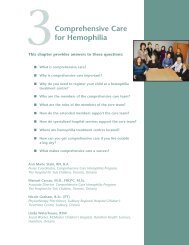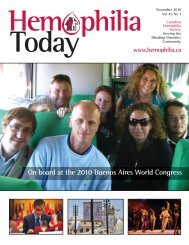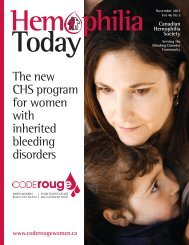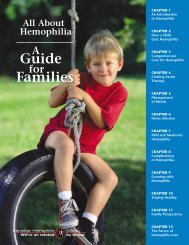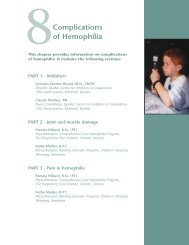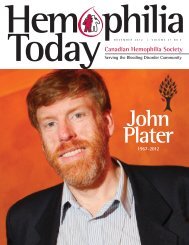Canadian Hemophilia Society Meeting the challenge
Canadian Hemophilia Society Meeting the challenge
Canadian Hemophilia Society Meeting the challenge
- No tags were found...
You also want an ePaper? Increase the reach of your titles
YUMPU automatically turns print PDFs into web optimized ePapers that Google loves.
Craig UpshawPresidentDavid PageNational Executive DirectorNew <strong>challenge</strong>s… new opportunities<strong>Canadian</strong> <strong>Hemophilia</strong> <strong>Society</strong>THIS ANNUAL REPORT focuses on <strong>the</strong> <strong>Canadian</strong> <strong>Hemophilia</strong> <strong>Society</strong>’s achievements in 2011, <strong>the</strong> first yearof our five-year strategic plan… and <strong>the</strong>y are considerable. A top-notch medical and scientific meeting inCalgary. An ever-more active research program with record levels of support to <strong>Canadian</strong> researchers. Highqualityeducation programs for people with bleeding disorders. Strong support for <strong>the</strong> health care providers inCanada’s 25 comprehensive care clinics. At <strong>the</strong> same time, we have worked to maintain access to an optimal supply ofclotting factor concentrates at no cost to <strong>the</strong> end user.However, we must already look to <strong>the</strong> future where <strong>the</strong>re are new <strong>challenge</strong>s and, hopefully, newopportunities.Since <strong>the</strong> introduction of factor concentrates in <strong>the</strong> late 1960s, we have seen some important changes,including major advances in safety, but none of <strong>the</strong>se changes significantly altered how well <strong>the</strong> productsworked. This is about to change. In <strong>the</strong> not-so-distant future, perhaps in 2014, <strong>the</strong> first longer half-life products willbe approved for use. For some, this could mean a reduction in <strong>the</strong> frequency of treatments required for prophylaxis.For o<strong>the</strong>rs, <strong>the</strong>se products could mean higher “trough” levels and better protection against bleeds (a trough is <strong>the</strong>lowest factor level between doses of prophylaxis). And <strong>the</strong>re has even been a breakthrough in gene <strong>the</strong>rapy, bringing<strong>the</strong> hope of a cure. Indeed, <strong>the</strong>se changes point to an exciting future, but <strong>the</strong>re are also storm clouds on <strong>the</strong> horizon.For <strong>the</strong> last 25 years, <strong>the</strong> CHS has successfully advocated for physician/patient choice and access to <strong>the</strong> mostadvanced treatment products. Doing so will be even more critical when <strong>the</strong> next generation of products hits <strong>the</strong>market. With <strong>the</strong> current health funding <strong>challenge</strong>s, we are already hearing questions around <strong>the</strong> cost of factorconcentrates, monitoring of product utilization and <strong>the</strong> merit (or lack of merit) of prophylaxis care for adults. We areseeing <strong>the</strong> emergence of evidence-based medicine and <strong>the</strong> need to show positive outcomes to justify all <strong>the</strong> dollarsinvested. The importance of documenting utilization of expensive factor concentrates has never been greater.Documenting product use with modern tools and linking it to health outcomes will be crucial to maintaining ouraccess to an optimal supply of <strong>the</strong> safest, most efficacious products.4



